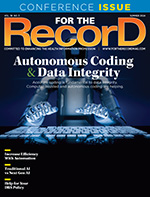Summer  2024 Issue
2024 Issue
Editor’s Note: Automation Matters
By Kate Jackson
For The Record
Vol. 36 No. 3 P. 4
Automation continues to be among the biggest buzzwords in HIM and likely will be for some time to come. Thus, it’s a topic that dominates this issue’s content—the subject of three of our four feature articles.
In “Navigating Prior Authorization,” John Garcia, chief product officer of Janus Health, looks at the challenges of prior authorizations and the consequences to providers and patients, exploring the ways in which automation may make a difference. “Ongoing labor shortage remains a big issue,” he writes,” prompting teams to explore workflow automation to resolve staffing challenges. Automation can be a worthwhile investment for prior authorization, making the process less taxing on both providers and patients.”
In “Autonomous Coding and Data Integrity,” contributor Susan Chapman explores the ways in which automation is influencing coding and data integrity, noting how it can reduce the likelihood of errors and create consistency. Further, she observes, it’s changing the nature of the profession. “In coding,” she writes, “AI-driven solutions are transforming the coder’s role from that of manual coding to one of a more analysis and audit.” In another feature, “The Impact of Generative Artificial Intelligence on Health Care,” she tackles the broad role and powerful impact of generative artificial intelligence in health care, observing that “When applied correctly, Gen AI can positively influence revenue cycle efficiency, clinical support, patient engagement and communication, and other areas of health care.”
Finally, departing from automation, Joe Licata, JD, provides guidance on another important issue in “The Designated Record Set: Answering Your Frequently Asked Questions.” According to Licata, “if HIPAA is the cornerstone of health care’s regulatory standards, then the designated record set is its foundation.” He offers a Q&A about the fundamental concerns.
Department articles tackle a broader range of HIM issues.
In “Identifying Patients With Dementia,” Sue Coyle, MSW, reports on investigators at Cedars-Sinai in Los Angeles who are using EHRs to identify patients with dementia upon hospital admissions to improve care and outcomes.
Susan Chapman writes about the difficulties associated with coding gender-affirming care and the consequences to patients when it’s improperly done. “When a claim is denied,” she explains, “ it places a burden on the patient, who often must help correct the denial.” Worse, in certain situations, patients may be forced to come out to their employers, which can have a detrimental effect on their well-being.
Selena Chavis, in “Understanding Antibiotic Prescribing and Improving Antimicrobial Stewardship,” looks at recent research suggesting that better documentation practices can combat the misuse of antibiotics.
In addition, Elizabeth S. Goar weighs in on the gamification of coder education, observing that it’s slow to take hold despite a growing body of evidence about its effectiveness, and, finally, Dava Stewart discusses safety and security issues for wearables such as Fitbits and Apple Watches.
— Kate Jackson
kjackson@gvpub.com



